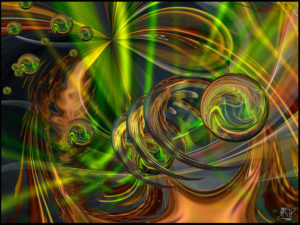Posted by Roberta Grimes • November 09, 2024 • 12 Comments
Book News, The Source, Understanding Reality
To everything turn, turn, turn,
There is a season turn, turn, turn,
And a time to every purpose under Heaven.
A time to be born, a time to die.
A time to plant, a time to reap.
A time to kill, a time to heal.
A time to laugh, a time to weep.
To everything turn, turn, turn,
There is a season turn, turn, turn,
And a time to every purpose under Heaven.
A time to build up, a time to break down.
A time to dance, a time to mourn.
A time to cast away stones,
A time to gather stones together.
– Peter Seeger (1919-2014), from “Turn! Turn! Turn!” (1965)
 Last week I witnessed one of the most shocking exhibitions of willful scientific and spiritual ignorance that I ever have seen, or that I could have imagined. My dear ones, it never is our intention here to name and shame those who have no way of knowing better. But we have always respected the Institute of Noetic Sciences (“IONS”), which was founded by the illustrious astronaut Dr. Edgar Mitchell, the sixth person ever to walk on the moon, and who had a spiritually transformative experience on his way back from the moon. I have understood that IONS truly does intend to “foster creative and leading-edge approaches to the scientific investigation of human consciousness,” as its own promotional materials proudly proclaim. So, wow, when I learned that IONS was about to award prizes for Breaking the Boundaries of the Brain: Exploring Pioneering Theories of Non-Local Consciousness, I was eager to learn a lot more about that!
Last week I witnessed one of the most shocking exhibitions of willful scientific and spiritual ignorance that I ever have seen, or that I could have imagined. My dear ones, it never is our intention here to name and shame those who have no way of knowing better. But we have always respected the Institute of Noetic Sciences (“IONS”), which was founded by the illustrious astronaut Dr. Edgar Mitchell, the sixth person ever to walk on the moon, and who had a spiritually transformative experience on his way back from the moon. I have understood that IONS truly does intend to “foster creative and leading-edge approaches to the scientific investigation of human consciousness,” as its own promotional materials proudly proclaim. So, wow, when I learned that IONS was about to award prizes for Breaking the Boundaries of the Brain: Exploring Pioneering Theories of Non-Local Consciousness, I was eager to learn a lot more about that!
 The IONS promotional materials for its awards presentation for a set of three prize-winning papers went on to say, “The finalists will share highlights from their award-winning reviews, and expand on leading non-local theories grounded in empirical evidence. The IONS science team will be on hand to discuss the profound implications.” And, “Whether you’re a scientist, practitioner, or simply curious about the mysteries of consciousness, this is a special opportunity to explore revolutionary ideas that could reshape our understanding of human potential and the very nature of reality.” The three prize-winners then presented papers to their online audience that amounted to nothing more than compilations of old guesses about how and where in the brain consciousness might be produced, and how these individual brain-produced consciousnesses might intermingle. Or it was something like that. To tell you the truth, all their trumpeted “leading-edge theories” would decades ago have been seen as nonsense among most modern researchers who have any clue. I lost interest in the whole thing pretty quickly.
The IONS promotional materials for its awards presentation for a set of three prize-winning papers went on to say, “The finalists will share highlights from their award-winning reviews, and expand on leading non-local theories grounded in empirical evidence. The IONS science team will be on hand to discuss the profound implications.” And, “Whether you’re a scientist, practitioner, or simply curious about the mysteries of consciousness, this is a special opportunity to explore revolutionary ideas that could reshape our understanding of human potential and the very nature of reality.” The three prize-winners then presented papers to their online audience that amounted to nothing more than compilations of old guesses about how and where in the brain consciousness might be produced, and how these individual brain-produced consciousnesses might intermingle. Or it was something like that. To tell you the truth, all their trumpeted “leading-edge theories” would decades ago have been seen as nonsense among most modern researchers who have any clue. I lost interest in the whole thing pretty quickly.
 The human brain does not produce consciousness. The brain is something in the nature of a transmitter and receiver, but nothing more. There is no evidence that the human brain produces consciousness, and there is so much good evidence by now that consciousness is primary and pre-existing that I was shocked to see such outmoded ideas being considered noteworthy by IONS. The fact that what we experience as consciousness is primary was first discovered by the father of quantum physics, Max Planck, more than a century ago. And it was certainly the greatest scientific discovery of the twentieth century. In 1931 Max Planck said, “I regard consciousness as fundamental. I regard matter as derivative from consciousness. We cannot get behind consciousness! Everything that we talk about, everything that we regard as existing, postulates consciousness.” Then he said in 1944, “As a man who has devoted his whole life to the most clear-headed science, to the study of matter, I can tell you as a result of my research about atoms this much: There is no matter as such. All matter originates and exists only by virtue of a force which brings the particle of an atom to vibration and holds this most minute solar system of the atom together. We must assume behind this force the existence of a conscious and intelligent mind. This mind is the matrix of all matter.” Albert Einstein eventually came to agree with him. Einstein is quoted as having said, “Concerning matter, we have been all wrong. What we have called matter is energy, whose vibration has been so lowered as to be perceptible to the senses. There is no matter.” All of this is pretty heady stuff! And many people were increasingly confident that before the end of the twentieth century, mainstream science’s brief flirtation with its false religion of atheistic materialism would be at an end. But all of this is still not broadly known even now, when we are already 25% of our way into the 21st century, only because even though matter is 99.9999999% empty space, materialist science as a discipline remains simply unable to cope with the concept of (gulp!) an entirely non-solid reality.
The human brain does not produce consciousness. The brain is something in the nature of a transmitter and receiver, but nothing more. There is no evidence that the human brain produces consciousness, and there is so much good evidence by now that consciousness is primary and pre-existing that I was shocked to see such outmoded ideas being considered noteworthy by IONS. The fact that what we experience as consciousness is primary was first discovered by the father of quantum physics, Max Planck, more than a century ago. And it was certainly the greatest scientific discovery of the twentieth century. In 1931 Max Planck said, “I regard consciousness as fundamental. I regard matter as derivative from consciousness. We cannot get behind consciousness! Everything that we talk about, everything that we regard as existing, postulates consciousness.” Then he said in 1944, “As a man who has devoted his whole life to the most clear-headed science, to the study of matter, I can tell you as a result of my research about atoms this much: There is no matter as such. All matter originates and exists only by virtue of a force which brings the particle of an atom to vibration and holds this most minute solar system of the atom together. We must assume behind this force the existence of a conscious and intelligent mind. This mind is the matrix of all matter.” Albert Einstein eventually came to agree with him. Einstein is quoted as having said, “Concerning matter, we have been all wrong. What we have called matter is energy, whose vibration has been so lowered as to be perceptible to the senses. There is no matter.” All of this is pretty heady stuff! And many people were increasingly confident that before the end of the twentieth century, mainstream science’s brief flirtation with its false religion of atheistic materialism would be at an end. But all of this is still not broadly known even now, when we are already 25% of our way into the 21st century, only because even though matter is 99.9999999% empty space, materialist science as a discipline remains simply unable to cope with the concept of (gulp!) an entirely non-solid reality.
 Consciousness and individual awareness are not the same thing, anyway. This seems to be a part of why the folks at IONS are so hung up on the gray matter inside the human skull. But then, of course, even plants are aware. Oh, yes indeed, the flowers by your garden bench are aware of you as you sit down beside them, and as you then sadly might confide in them that you and your beloved are having a tiff. It is becoming possible for us to imagine now that on some level, even individual cellular life might well be to some extent aware. Indeed, since consciousness is so basic, we might now be coming to see that individual awareness might be one of the features of life itself. And incidentally, I should make it clear that I don’t like doing this naming-and-shaming. In point of fact, doing it horrifies me. But IONS is a prestigious nonprofit organization! And if any such institution holds itself out to the public as being on the cutting edge of consciousness research, but then it refuses to hold itself to a standard of pursuing the objective truth wherever it may lead, then those who are dedicated to pursuing the truth break the public’s trust if we fail to call them out.
Consciousness and individual awareness are not the same thing, anyway. This seems to be a part of why the folks at IONS are so hung up on the gray matter inside the human skull. But then, of course, even plants are aware. Oh, yes indeed, the flowers by your garden bench are aware of you as you sit down beside them, and as you then sadly might confide in them that you and your beloved are having a tiff. It is becoming possible for us to imagine now that on some level, even individual cellular life might well be to some extent aware. Indeed, since consciousness is so basic, we might now be coming to see that individual awareness might be one of the features of life itself. And incidentally, I should make it clear that I don’t like doing this naming-and-shaming. In point of fact, doing it horrifies me. But IONS is a prestigious nonprofit organization! And if any such institution holds itself out to the public as being on the cutting edge of consciousness research, but then it refuses to hold itself to a standard of pursuing the objective truth wherever it may lead, then those who are dedicated to pursuing the truth break the public’s trust if we fail to call them out.
 Speaking of the truth about consciousness, perhaps the most transformative book that I ever have read in this field is The Secret Life of Plants by Peter Tompkins and Christopher Bird. I first read it in 1973, and I didn’t realize until much later the way that book had formed a basis for my ongoing afterlife research. It opened my eyes to a deeper awareness that nothing really is as it seems; it primed me to later on accept the evidence that what we experience as human consciousness really is primary; and it showed me, too, how sadly closed-minded and unable to accept even basic truths about reality mainstream scientists really still are!
Speaking of the truth about consciousness, perhaps the most transformative book that I ever have read in this field is The Secret Life of Plants by Peter Tompkins and Christopher Bird. I first read it in 1973, and I didn’t realize until much later the way that book had formed a basis for my ongoing afterlife research. It opened my eyes to a deeper awareness that nothing really is as it seems; it primed me to later on accept the evidence that what we experience as human consciousness really is primary; and it showed me, too, how sadly closed-minded and unable to accept even basic truths about reality mainstream scientists really still are!
 That book’s core insight from my perspective was that even plant-fragments are conscious, in the sense that they are aware, and they actually are able to communicate. What a revelation that was! Consider only the work of Cleve Backster, who back in the nineteen-sixties was America’s foremost expert on lie detectors. One morning in 1966, he randomly decided to use his office plant as an experimental subject. He attached to one of its leaves a galvanometer, which is the part of a polygraph machine which registers human emotions. And he found to his surprise and delight that the plant was reacting very much as a person would react who was having transient thoughts. Wow, that was interesting! He soon found, too, that the most extreme reactions in his plant were produced when he decided to burn one of its leaves. But the plant’s reaction was less if he only imagined burning the leaf, without intending to actually do it; surprisingly, the plant could tell the difference. Or it reacted differently if he outright burned a leaf, without thinking about it beforehand. His plant also would react if other living things in the room were credibly threatened with harm. Backster and other researchers later demonstrated that these reactions are present even in living fragments of plants. My goodness, plants even can read the minds of their familiar keepers from a distance of miles away! There is so much more to Backster’s work that mainstream science still ignores. These amazing revelations are now almost sixty years old, and they are all by themselves sufficient reason for you to read one of the most amazing and most unjustly ignored books in human history!
That book’s core insight from my perspective was that even plant-fragments are conscious, in the sense that they are aware, and they actually are able to communicate. What a revelation that was! Consider only the work of Cleve Backster, who back in the nineteen-sixties was America’s foremost expert on lie detectors. One morning in 1966, he randomly decided to use his office plant as an experimental subject. He attached to one of its leaves a galvanometer, which is the part of a polygraph machine which registers human emotions. And he found to his surprise and delight that the plant was reacting very much as a person would react who was having transient thoughts. Wow, that was interesting! He soon found, too, that the most extreme reactions in his plant were produced when he decided to burn one of its leaves. But the plant’s reaction was less if he only imagined burning the leaf, without intending to actually do it; surprisingly, the plant could tell the difference. Or it reacted differently if he outright burned a leaf, without thinking about it beforehand. His plant also would react if other living things in the room were credibly threatened with harm. Backster and other researchers later demonstrated that these reactions are present even in living fragments of plants. My goodness, plants even can read the minds of their familiar keepers from a distance of miles away! There is so much more to Backster’s work that mainstream science still ignores. These amazing revelations are now almost sixty years old, and they are all by themselves sufficient reason for you to read one of the most amazing and most unjustly ignored books in human history!
 This discovery that even living plant-fragments are not just conscious and able to communicate, but that they actually seem to be aware in the same way that human beings are aware, despite the fact that plants have no brains at all, still fills me with wonder. And of course, it further demonstrates the frank silliness of our clueless friends at IONS, who still continue to look for a source of consciousness inside the human brain, almost as if they are a group of Australian aborigines, perhaps, clustered around a radio and trying to find inside it all the little instruments making the music that is emanating from it. Many years ago, Cleve Backster’s pioneering work formed a basis for my own growing research-based awareness that what we experience as consciousness has to be primary. There is no other explanation that fits all the evidence. So when in 2011 I read that ultimate quantum-physics-for-dummies book, Quantum Enigma by Bruce Rosenblum and Fred Kuttner, and I found that the greatest of all quantum physicists had many decades before reached the same set of conclusions that I was reaching now, I had a joyously ultimate eureka moment.
This discovery that even living plant-fragments are not just conscious and able to communicate, but that they actually seem to be aware in the same way that human beings are aware, despite the fact that plants have no brains at all, still fills me with wonder. And of course, it further demonstrates the frank silliness of our clueless friends at IONS, who still continue to look for a source of consciousness inside the human brain, almost as if they are a group of Australian aborigines, perhaps, clustered around a radio and trying to find inside it all the little instruments making the music that is emanating from it. Many years ago, Cleve Backster’s pioneering work formed a basis for my own growing research-based awareness that what we experience as consciousness has to be primary. There is no other explanation that fits all the evidence. So when in 2011 I read that ultimate quantum-physics-for-dummies book, Quantum Enigma by Bruce Rosenblum and Fred Kuttner, and I found that the greatest of all quantum physicists had many decades before reached the same set of conclusions that I was reaching now, I had a joyously ultimate eureka moment.
 All of this came to mind again when I read a wonderful article in Smithsonian Magazine back in 2018, which is unfortunately paywalled. It was called “Do Trees Talk to Each other?” Well, of course they do! Peter Wohlleben is a German researcher now popularly known as the “Tree Whisperer” whose book, The Hidden Life of Trees, is now available in English. If you subscribe to the Smithsonian Magazine so you can read the article, or if you buy and read his book, you will forever after see each forest of any size as a thriving community of sentient individuals in constant and heavily involved communication with one another, caring for their young, and even caring for their old and for the stumps of those felled by people. They are caring, too, for other benevolent creatures, and fighting off anything that means to do them harm. You will never look at any plant of any size in the same way again!
All of this came to mind again when I read a wonderful article in Smithsonian Magazine back in 2018, which is unfortunately paywalled. It was called “Do Trees Talk to Each other?” Well, of course they do! Peter Wohlleben is a German researcher now popularly known as the “Tree Whisperer” whose book, The Hidden Life of Trees, is now available in English. If you subscribe to the Smithsonian Magazine so you can read the article, or if you buy and read his book, you will forever after see each forest of any size as a thriving community of sentient individuals in constant and heavily involved communication with one another, caring for their young, and even caring for their old and for the stumps of those felled by people. They are caring, too, for other benevolent creatures, and fighting off anything that means to do them harm. You will never look at any plant of any size in the same way again!
 What you and I experience as human consciousness is the base creative force. And consciousness is all that objectively exists! Consciousness is how each of us relates to God. Consciousness is the water in which we swim, it is the air beneath our wings, and in point of fact, there really is nothing else. So it should not really surprise us much to find that every living thing is in some way conscious. And in fact, that may be true of even what we now consider to be non-living things. If consciousness is the base creative force, then perhaps even rocks might be somehow conscious? One of the things that we generally do when we first return to our eternal home after each earth-lifetime is sightseeing, on other planets and even in other realities. I recall long ago reading an early-twentieth-century account received through a deep-trance medium from someone who had been enjoying doing his post-earthly-death touring. And he talked about a planet where the life was not carbon-based, but instead it was silica-based. He told his listening loved ones through that medium that the entire planet he just had visited had turned out to be teeming with life! But you didn’t realize that for a while, because all that life moved ve-e-e-ry sl-o-o-o-wly. And you know, come to think of it, the rocks on this planet are moving very slowly, too….
What you and I experience as human consciousness is the base creative force. And consciousness is all that objectively exists! Consciousness is how each of us relates to God. Consciousness is the water in which we swim, it is the air beneath our wings, and in point of fact, there really is nothing else. So it should not really surprise us much to find that every living thing is in some way conscious. And in fact, that may be true of even what we now consider to be non-living things. If consciousness is the base creative force, then perhaps even rocks might be somehow conscious? One of the things that we generally do when we first return to our eternal home after each earth-lifetime is sightseeing, on other planets and even in other realities. I recall long ago reading an early-twentieth-century account received through a deep-trance medium from someone who had been enjoying doing his post-earthly-death touring. And he talked about a planet where the life was not carbon-based, but instead it was silica-based. He told his listening loved ones through that medium that the entire planet he just had visited had turned out to be teeming with life! But you didn’t realize that for a while, because all that life moved ve-e-e-ry sl-o-o-o-wly. And you know, come to think of it, the rocks on this planet are moving very slowly, too….
More and more, it is becoming clear that accepting Max Planck’s genius insight that consciousness is primary is going to be essential if scientists are ever to end their now more than century-long materialist muddle. As incredible as it now seems to us, the scientific community has of course known for more than a century that Max Planck and Albert Einstein and many of mainstream science’s other greatest historical heroes were sure that consciousness is primary, and materialist scientists are coming to see at this point how their dogma-hobbled research is stalling out. And yet, they still have been unable to drop materialism as their fundamental dogma. A Nobel Prize awaits the first truly open-minded physicist who is brave enough and smart enough to finally and forever remove his own materialist chains and come up with a viable Consciousness Theory of Everything!
To everything turn, turn, turn,
There is a season turn, turn, turn,
And a time to every purpose under Heaven.
A time of love, a time of hate.
A time of war, a time of peace.
A time you may embrace,
A time to refrain from embracing.
To everything turn, turn, turn,
There is a season turn, turn, turn,
And a time to every purpose under Heaven.
A time to gain, a time to lose.
A time to rain, a time to sow.
A time for love, a time for hate.
A time for peace, I swear it’s not too late!
– Peter Seeger (1919-2014), from “Turn! Turn! Turn!” (1965)
(Many photos are from Vecteezy.com)
Great job of reporting here Roberta. What you wrote deserves elaborating.
Your foundational truth is clearly states here as:
” Consciousness is the water in which we swim, it is the air beneath our wings, and in point of fact, there really is nothing else. So it should not really surprise us much to find that every living thing is in some way conscious. And in fact, that may be true of even what we now consider to be non-living things. If consciousness is the base creative force, then perhaps even rocks might be somehow conscious? ”
In other words any and all entities contain consciousness, even if we cannot sense that with our physical mortal senses. Logically, that must be so. When God creates anything, He (and of course God is not simply one sex, so”He is a convenience) cannot go to any cosmic Home Depot or Lowes to shop. What God creates comes from His vry one consciousness, so everything must possess His consciousness. Thus, not only fo plants possess consciousness, but so does water, rocks, and noteably our own brain/body–in our normal mental life we have two sources of consciousness, with one eminating from our body/brain, and the other our attached mortal soul, and there is evidence for this remarkable observation.
In a paper I recently published ( Hiller, JH, 2021Evidence of the Body Possessing a Form of Consciousness Beyond Its Soul ), I report on cases in which an individual having gone Out of Body, and not then in control of their body’s behavior, watcyhed as their body continued to perform rationally. For example, in one case the person watcher their body swim to shore instead of drowining, In another case, a motorcyclist who was hit by a truck, punched the truck driver who came over to help–while the individual watched his body do that on its own. Here is the Abstract for my research paper:
Freud defined three primary psychoanalytic functionalities for motivating behavior that have fallen into disuse: 1. The ID motivating instinctive behaviors, such as satisfying hunger drives and reaction to immediate threat; 2. The Super Ego pursuing moral ideals, such as self-sacrifice and honesty; and 3. The Ego for resolving conflicts between the ID and reality, and accommodating Super Ego demands. Freudian Theory is now generally regarded as detached from the current science paradigm which seeks to anchor behavioral theory in brain neurology. Whereas the ID and Ego may be mapped to identified areas of the brain, no Super Ego brain locality has been identified. This analysis proposes a solution for the missing Super Ego. The Out of Body Experiences reported from the trauma of a Near Death Experience (NDE) or meditation describe a discarnate consciousness or soul that is inherently moral as it functions in a Universal Field of Consciousness. This paper reifies the Freudian Super Ego to be equivalent to the soul and thus supports revitalization of Freudian Theory as valuable for clinical practice and personality research.
In a paper I had published a few months ago, I was able to explain how the non-locality of instantaneous quantum entanglement relies on consciousness. Entering my name and “Quantum Entanglement Explained” will locate the paper for reading. Currently, conventional materialistic physics has no explanation whatsoever for instantaneous “spooky action at a distance.”
So, in addition to our body having an attached consciousness (soul), it also generates its own consciousness which is key for staying alive, and these two sources of consciousness may often fall into conflict avbout how to behave, with the body’s consciousness being selfish and greedy, while the soul seeks a moral path.
Dr. Jack H Hiller.
Freud’s “Great Secret” :
https://sharylattkisson.com/2024/07/report-videos-showing-georgia-election-workers-re-scanning-same-ballots-on-multiple-machines/#comment-185143
-Rick
Oh well….
Oh my dear Jack, this is so fascinating! Thank you for sharing it!!
As an avid gardener, your comments regarding the consciousness of plants and their ability to communicate are on the mark. It explains why some of us have “green thumbs” while others insist everything they put in the ground dies. I have one very productive apple tree in my backyard and never forget to thank it at the end of the season for the bountiful harvest. When I share these apples with relatives and friends, they usually get back to me by letter, phone or in person to say that my apples are the best they have ever tasted.
Oh, my dear Thomas, how wonderful! And I’ll bet that you lavish that tree wiith a lot of love and care!
My parents had a beautiful mature lemon tree in their garden. It had never born a single lemon so, one day, Dad announced to Mum standing beside him, in front of the tree, ” If this tree does not bear fruit next season, I will cut it down and plant a new one.” The tree had a huge crop of lemons the following year and continued to be highly productive for the remainder of Dad’s life.
Mandi, That’s great. It also illustrates why experimental science requires a control; here it would be two trees (the more the better) from the same parents, with one warned and the other not. Cosmology suffers from its inability to experimentally manipulate potential causation, although much useful information is gathered by passive observation. Likewise, the field of research into the nature of consciousness suffers from a lack of experimentation to test theory.
I agree. There is not enough attention paid to the nature of consciousness
Absolutely, my dear Lola!
True, Jack, but isn’t that a great story? There is one like it in the Bible, using a fig tree.
Oh my dear Mandi, you actually made me laugh out loud! I love it!!